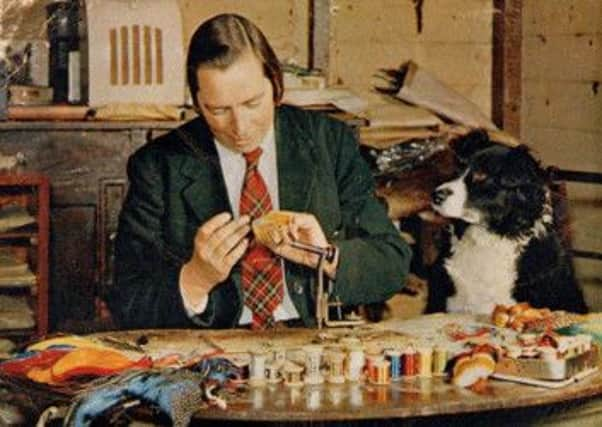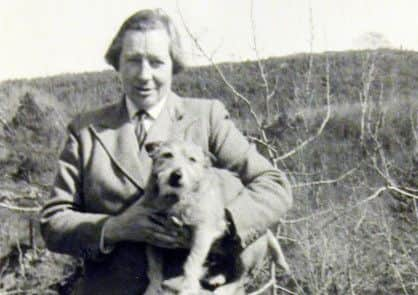Lady of the Flies: Previewing Kiss the Water


According to The American Fly Fisher magazine, Megan Boyd’s flies were “the Tiffanies of the 20th century”. They have names as glittering as jewels too, or as strange as magic spells. The Jock Scott, the Silver Doctor, the Woolly Hugger. Or what about her most famous and devastating creation of all: the Megan Boyd? According to her New York Times obituary, it’s “a nifty blue and black number famous for attracting salmon at the height of summer, when the water is low, hot and dead”. This small and comparatively modest lure was revered by fishermen who beat a path to her door for the fly of last resort. The only one that could bring in the salmon when they refused to bite. Yet its creator, a deeply unconventional recluse who worked tirelessly for 60 years tying tens of thousands of flies in a corrugated iron shed near the village of Brora in Sutherland, never caught a fish in her life. “I wouldn’t kill a salmon if I got one,” she once said.
Boyd died in 2001 at the age of 86. She was one of the world’s greatest fly tiers and surely one of the craft’s most fascinating characters. Her NYT obituary is every bit as charming as its subject, ruminating on such satisfying details as her “usual dress: a man’s shirt and tie, sweater, wool skirt, tweed sports jacket and heavy army-style boots” and how “she cut her own hair in a style the British call an Eton Crop”. When American filmmaker Eric Steel came across her remarkable life story, he was similarly intrigued. He had read the NYT obits every day for as long as he could remember but there was something about this one. He clipped it out, pinned it to his wall and spent the next decade imagining the life between the lines.
Advertisement
Hide AdAdvertisement
Hide Ad“I wasn’t even a filmmaker when I read it,” he tells me from his home in Long Island, New York State, which like the vista from Boyd’s remote cottage in the northeast Highlands, faces east across an ocean. “I’m not a fisherman. I’d never been to Scotland. I don’t even eat salmon. So it was something else in this story that got me. It was a strange modern fairytale. Here was this woman in an old cottage in a faraway land spinning tiny pieces of feather, fur and tinsel around metal hooks. It reminded me of the maiden in Rumpelstiltskin who is told to spin straw into gold. Or Cinderella, who works her fingers to the bone.”


Life went on. Boyd’s flies were traded on eBay for increasingly large amounts. They now sell for thousands and can be found in museums and private collections all over the world. The kidney-shaped dressing table that served as her work bench and materials were auctioned off. Her Sutherland cottage became more rundown, battered and consumed by sea and land. In the meantime Steel made The Bridge, an acclaimed documentary about jumpers off the Golden Gate Bridge. And then finally the fairytale of Boyd’s life reeled him in. He decided to make a film about her.
“I approached Creative Scotland and they generously funded my initial visits to the Northern Highlands,” he says. What did he do when he got there? “We drove up to her cottage. It’s been abandoned and is completely swallowed up by the vegetation. You can barely make out the eye of a window. The doors are open, the glass is missing, and there are pigeons and all sorts of creatures living in there. But there is still a paraffin lamp in the window of her studio, her charts glued to the wall, and her curtains up in the living room.”
Steel visited local villages and walked the rivers with fishermen, ghillies and the town elders. “People were incredibly open and eager to tell Megan’s story,” he says. “She was one of those prized local characters. We went to the Helmsdale fishing supply shop which is the locus for all the fishermen on the rivers up there. I realised to be a fisherman you have to be a superb storyteller. They told me that Megan was the greatest reader of the rivers around even though she had never been fishing. That notion of being interested in the subtext or sub-surface of the water and the mystery of why the salmon is lured by the fly in the first place became a metaphor for my investigation. I wanted to go deeper, to get beneath the surface of this woman’s life.”
The result is Kiss The Water, an impressionistic and meditative cine-poem about one woman’s monastic devotion to her craft, the unforgiving landscape of Sutherland, and the mysterious journey made by Atlantic salmon up river to spawn. We glimpse all sorts of wonderful details about Boyd. She lived without electricity, running water, or a phone, working 16 hours a day, seven days a week, tying flies by the light of a paraffin lamp after dark. Local customers filled out their orders in a notebook tied to a chair outside her cottage. She dressed like a man and loved ceilidhs and Scottish country dancing. She was a notoriously bad driver, known to speed through villages on a motorbike while the local lads cheered her on.
Yet Kiss The Water is about absence as much as presence. We don’t, for example, get to see an image of Boyd until the final frame of the documentary. We don’t really ever get to see beneath the surface of the water. So who was Megan Boyd? “She was a mystery,” Steel replies. “She was outside the centre – outside the village, outside convention. She was an artist. You can’t make one of her flies casually. She had extraordinary precision. One fly tier who was taught by her told me he would spend two months on a single fly, post it to her, and she would write back to tell him what he had done right and wrong and make him do it again.
“Every time you think you’ve got her, she slips away,” he says. “She created some elaborate flies that weren’t the most practical or effective, yet some were famed for luring the biggest salmon every single time. She always said she made the flies for the fishermen not for the fish. They were beautiful objects but also incredibly functional.”
It’s this perfectionism – and the fact that they always did the job – that made her flies so famous. A collector once wrote in a letter to the Inverness Courier: “Her fly-tying was unique. The trouble she took over just arranging the pieces of hair for the Stoat’s Tail fly had to be seen to be believed. She used to put these hairs in the top of her lipstick holder with the ends sticking out and she said they should never be trimmed or cut as this was unnatural to the fish.”
Advertisement
Hide AdAdvertisement
Hide AdThe youngest of three children, Boyd was thought to have been born in England in 1915 and taken to Scotland three years later. Her father became a ghillie on a Sutherland estate and by the age of 12 Boyd had tied her first fly under the tutelage of a local keeper. She used the money from her first sale to go to London and buy her father a suit. During the war she worked as an auxiliary coastguard and delivered milk locally.
By the mid-1930s Boyd had moved into her cottage overlooking the North Sea where she would spend the next six decades tying some of the most beautiful and successful flies in history. Anglers would regularly make the pilgrimage to her home. Prince Charles even showed up and bought her flies, though notoriously on one occasion she had to turn down his order because she was on her way to a dance. Eventually she was awarded the British Empire Medal by the Queen although she refused the invitation to Buckingham Palace because she didn’t want to leave her dog. The Prince of Wales later presented it to her at a fishing lodge near her home. He visited Boyd in a nursing home not long before she died. She retired in 1985 because her eyesight was deteriorating. Nevertheless she would continue to tie flies in the dark, even when she could no longer see.
“She was one of a kind,” says Steel. “She devoted her entire life to her craft. It took her eyesight. She was always alone. I don’t believe she wanted that. People don’t set out to be on their own. I suppose it’s like setting out to catch a fish. It doesn’t always happen, does it?”
Kiss The Water is at the Edinburgh International Film Festival, tonight at 5.30pm, tickets £6, Cineworld 11, and Tuesday, tickets £6, Cineworld 8, www.edfilmfest.org.uk